![]()
![]()
![]()
Use LEFT and RIGHT arrow keys to navigate between flashcards;
Use UP and DOWN arrow keys to flip the card;
H to show hint;
A reads text to speech;
80 Cards in this Set
- Front
- Back
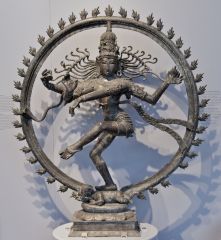
|
Shiva as Nataraja, or Lord of the Dance, Naltunai Isvaram Temple, Punjai, India, c. 1000, bronze. graceful a man stands in perfect balance lord of the unending dance multiple arms-power wisdom-third eye holds a drum-stands for creation and passing time snake-regeneration mudra-protection flame-destruction dance-release from earth circle of fire- transformation of the universe and its destruction |
|
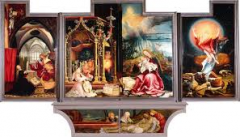
|
Matthias Grünewald, The Isenheim Altarpiece: Crucifixion, center panel, Germany, c. 1510–1515, oil on wood Christian - jesus in death shows redemption from sin bleeding into a chalice- symbolizes animal sacrifice saints- cures for the sick the painting was a form of consolation for patients in a hospital they could see the suffering of jesus and can relate to there suffering opens up into three joyful scenes of Jesus 1. conception 2. birth 3. resurrection from the dead |
|
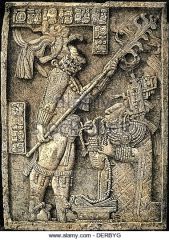
|
Shield Jaguar and Lady Xoc, classic Maya from a palace at Yaxchilan, Chiapas, Mexico, c. 750, relief. A ceremony Mayan ruler holds a torch over his wife as she pulls a thorny rope through a hole in her tongue those who participated had to be high ranking shown by there jewelry flattened forheads- sign of beauty did this for the new ruler of his son mayan writing on top and side |
|
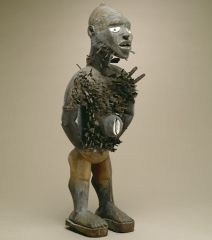
|
20 Power Figure (Nksisi n’kondi), Kongo, Zaire, c. 1998, wood, nails, blades, medicinal material with cowrie shell. sculpture that was used to counter the evil influence of enemies open mouth- will speak out Africans placed medicine in the abdomen back or head then released he figures power by driving in one metal nail for each request for help once effective, they would remove the nail "form of prayer" |
|
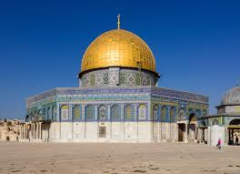
|
Dome of the Rock, Jerusalem, Israel, 687–692. built by Abdal Malik as a monument triumph of islam burial place of adam Abraham'sthe alter Ambrahams son Isaac was saved by the angel The Hebrew temple at Jerusalem destroyed by the roman emperor titus in 70 and the stone from which mohammed asceded to heaven then returned to his home in mecca influenced by Roman Byzantine architecture |
|

|
Iktinos and Kallikrates, Parthenon, Athens, Greece, 447–432 BCE, marble. greek temple Doric style when standing away from it it looks perfectly made but when walked up to it, its not proporsional they used the |
|
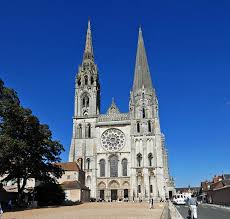
|
Chartres Cathedral, Chartres, France, 1145–1220. spiral symbolizes linking heaven and earth flying buttresses Ignorechartres is symmetrical and its shape is a cross symbolizing Jesus crusifiction |
|
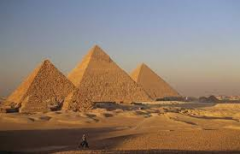
|
Great Pyramids, Gizeh, Egypt. 2525–2550 BCE. oriented to the sun tombs of pharaohs believed to be the sons of the most powerful of all the gods Re the sun God had many riches in there tombs to bring with them to the after life but were taken shortly after by thieves Pharoahs stopped building pyramids instead rulers were buried in less costly chambers cut deep into the sides of mountains with hidden entrances to not get robbed by thieves. |
|
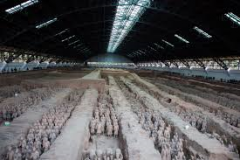
|
Soldiers from Pit 1, near the tomb of Shi Huangdi, Shaanxi, China, 221–206 BCE, painted ceramic every face is different and are life size and sculpted with great skill four different kinds of soldiers cavalry, archers,lancers, and fighters all sculpted four inches shorter then the commanders bronze spears,swords,crossbows painted in vivid colors Shi Huagdis army so when he comes back he will be ready to take back china the horses were as big as the sodiers |
|
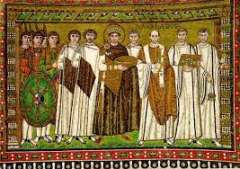
|
Emperor Justinian and His Attendants, Church of San Vitale, Ravenna, Italy c. 547, mosaic on the north wall of the apse. devoted Christian he is infront of all soldiers and state leaders but the priest is infront of him. but his arm is over him showing that he is in power is holding the bowl with bread empress Theodora and her attendants (justinians wife) equal rank and power she is holding the chacil of wine maximianvs |
|

|
Plaque with Warrior and Attendants, Benin, Nigeria, 17th or early 18th century. nigarian warrior king larger than his two attendents three heads high to show royalty-absolute authority acceptnever appears axcept in war and at ceremonies |
|
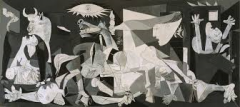
|
Pablo Picasso, Guernica, Spain, 1937, oil on canvas. destruction of the Basque capital during the Spanish civil war german nanzi planes bombed the city which burned for three days and left more then 1,000 dead surrealism with his own style of cubism bull-spain doomed to be tortured and suffer a slow death dying horse- Spanish republic while falling solider holding broken sword represents the spirit of resistance against tyranny other heads- shocked and suffering people electric bulb shaped like an eye- world is being shown in inhumanity. he says painting is an instrument of war for attack and defence against the enemy |
|

|
Maya Ying, Lin, Vietnam Veterans MemorialWashington, D.C., 1982, granite. names of more than 58,000 men and woman who died in Vietnam war are carved in black granite its polish surface reflects the faces of the living and forces a personal connection of the names of the dead set into the ground with one end pointing to the Washington monument a symbol of national unity and the other end pointing to the Lincoln memorial underground because all who died |
|
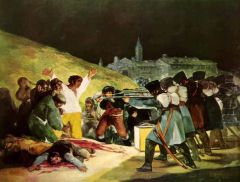
|
Francisco Goya, The Executions of May 3, 1808, Spain, 1814, oil on canvas. • The black man is surrendering, and symbolling as “Jesus crucifixion” has red dot on his hands resembling a stigma a nail through his hands but it should be on the wrists. People depicted this. Usually on the hand in art. • Napoleon spread French empire all the way through Spain. • The Spanish rebel after they conquer, French respond with a massacre on the 3rd of may • Man vs machine (machine of soldiers) there killing everyone including monks • Monk in picture because has shaven head, they shave it this way because it is not attractive, when become a monk you can’t care about being attractive • Uses light color gesture contrast for emotional impact, example of Romanticism Other artists working in this style Gricault DelacroixEmphasis on emotion over reasonUses color line contrast to make the viewer feel the message instead of thinking first Belief that reason is not enough. |
|
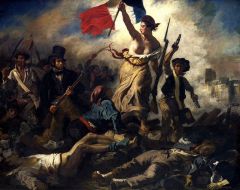
|
Eugène Delacroix, Liberty Leading the People, France, 1830, oil on canvas. She is not a human being an allegory (represents Liberty) because her boobs are out Young kids involved, all different types of people joining in Trying to make you emotionally involved and wanting to join Barricades: People go down the streets takes a bunch of stuff and block streets making barricades majorly effective way to make revolutions while they are up in the buildings shooting them while they try to take it down No more tiny streets no more barricades no more revolutions |
|
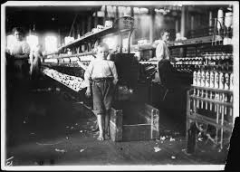
|
Lewis Hine, Leo, 48 Inches High, 8 Years Old, Picks Up Bobbins at 15¢ a Day, United States, 1910, photograph young boy who picks up lose thread spools ran the risk of injury or death from moving machinery worked 10-12 hours 6 days a week making school impossible poor, overworked owners hired these kids cuz cheap hine documented the youthfulness of the child laborers by giving his photos long titles emphasizes large machines and a small child his name is leo staffed by woman-underpaid group hine worked with National Child Labor Committee-private group proteting children published in magaiznes which made his work successful in changing both public opinion and public policy child labor was outlawed in the 1930 |
|
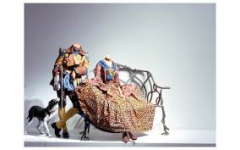
|
Yinka Shonibare, Mr. and Mrs. Andrews without Their Heads, England contemporary british artist beheaded the aristocrats recalling the fate of the ruling class printed cotton cloth idealizing African culture made in batic method all cultures are intertwined and hybridized based his sculpture on the 18th century mr. and mrs. Andrews which showed riches French were skeptical about it because no heads and the guillotine |
|

|
1) Figure 10.19 Kara Walker, “They Waz Nice White Folks While They Lasted” (Says One Gal to Another), United States, 2001, cut paper & projections on wall. based on racist imagery of the slave era based on fact and fantasy says that she does this because they are controversial and should be discussed usually black people getting hung, rapped, bastard children black woman squeezing out multiple babies slaves being tortured both humerous and shocking |
|

|
Polykleitos, Doryphoros (Spear-Bearer), Rome, c. 450–440 BCE, marble. presents the human body in ideal terms, although it varies from culture to culture indivduals- self govern greeks believes that humans were capable of near perfection defined as a fit body by a keen mind emotions considered less important that the intellect should be properly contained 1. idealized man by a balanced pose 2. internal proportions restrained emotions in the roled depicted youth athlete and warrior CONTRAPPOSTO-counterbalanced - the way people stand recreates tehe image of a living flexing body |
|
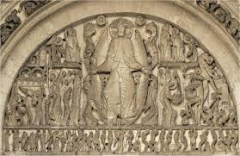
|
Gislebertus, The Last Judgment (West tympanum of the Church of St. Lazare), Autun, France, c. 1130, stone carving. Romanesque style the end of time whene very person rises from the ground to be judged forever as worthy of heaven or condemned to hell lower section-humans huddled in line until large hands clamps around there heads then are but on the scale of judgement they risk being snatched by demons and put in hell for enternity the saved souls are snatched by angels Jesus is in the center and depicted in grand manner reigning over heaven and earth and much larger then others right side of Jesus-everything is good left side of Jesus- everything badRight side bottom- using the body to be distorted to show people are imperfect-people still uncertain Left sidePeter- has the key to heaven gatekeeperOld architecture (church)-going to hellNew architecture (church)–going to heavenScale-good things with angel bad things with demandsMary St. Peter in the middle on the way bottom dead people are arising |
|

|
Michelangelo Buonarroti, David, Italy, 1501–1504, marble. david and goliath saved his people and later became the greatest king of the old testament head and hand are oversized indicating youthful potential still maturing davids inner tension speaks of the soul that is separate from the body he has a stone in his hand and a slingshot int he other |
|

|
Umberto Boccioni, Unique Forms of Continuity in Space, Italy, 1913. the body is a mass of wave energy considered less than a human defines muscle futurism energy, motion, change resting on a pedestal |
|
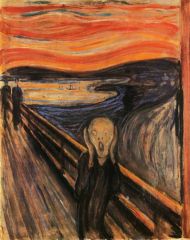
|
Edvard Munch, The Scream, Norway, 1893, oil painting. • The second of five children • His mother died when he was five • One sis was schizophrenic and regularly institutionalized • The family was very poor he was quite sickly • His sis did at 15 he was 13 ( he repainted the sick child six times throughout his life) • His father died when he was 23 • His relationships were mostly terrible often with married women • He made the scream when he was 30 • He lives to 80 but thins do not get better he spent some time in mental hospitals-alcoholism depression o Scream 1893 –makes four versions made a poem in one of them o The scream of nature, he only feels it when his to friends walk on and cant hear it o The fence- shows that we are kept away from nature life and separating us from it o Puts poem in past tense, showing that its his memory and is still bothering him o Wants it to look raw and rough o Depicts a real hill from which you could hear the patients at the mental hospital where his sister was and the animals at a slaughterhouse (under bridge)- there not really hearing screaming the fence is seperating them from nature |
|

|
Jackson Pollock, Lucifer, United States, 1947, oil, aluminum paint, and enamel on canvas gestural abstraction or "action painting" • From Wyoming his father was a farmer • Early training with Thomas hart Benton • Drip technique, very large works • Painted on the floor, expressing inner emotions • Action painting-shows how he did it No foreground/background • Not abstract- doesn’t start with the world started with a feeling • Expresses his feelings, believes that nothing is an accident-cigs buds dropped in painting doesn’t take out 10-31-16 |
|
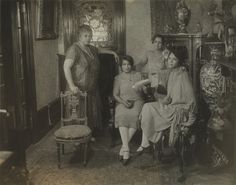
|
James VanDerZee, Society Ladies, United States, 1927, photograph. black middle class poses variety of emotion including confidence, humor encouraged them to take poses from the films canderzee was influenced by 1920s movies provided costumes and props to expand there personalities using the sense of wealth from the past showing that they are tough |
|
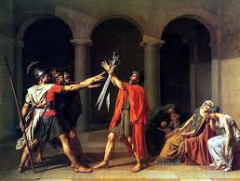
|
Jacques-Louis David, Oath of the Horatii, France, 1784, oil on canvas. 3 brother fight for city (huratii) fights against Curatii Intermarriage between them there father hands them swords they swear to go and fight for there city All the curatii killed and 2 out 3 die in huratii She is Mourning dead fiancé, her brother kills her because she mourned instead of celebrating cared more for fiancé then city Woman are more worried about themselves and families and not there countries Making scene to show you should support your country more then your family shows the reality of gender roles |
|
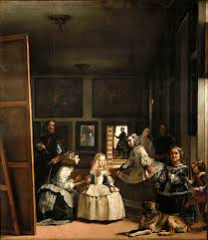
|
Diego Velazquez, Las Meninas, Spain, 1656, oil on canvas. Two lady maids and a child in white center (princess) who is saying goodmorning to her parents before starting her day MArgarita the daughter of King Philip IV and Queen Marian of Spain Dwarfs with there dog who are her entertainment Painter about to paint cuz he is dipping his paint brush Mirror in the back showing a picture of the king and queen zoomed into them Velazquez is painting the king and queen that is the riddle We are the spectator Doesn’t like painting regular portraits for interested in riddles so he made one Poses show that she is underclass (maids curtsying) Cross on V significant showing wealth and he is tall showing more powerful then king queen and princess the painting is 10 ft tall |
|
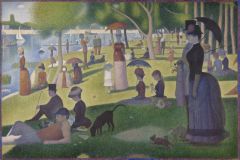
|
Georges Seurat, La Grand Jatte, France,1884–1886, oil on canvas. • Tourist spot near Paris • Ppl move to the cities then leave every weekend • Middle and lower class go to the same spots • Giant wall size painting (in Chicago) this is his biggest major work • Men not supposed to show arms like woman cant show there ankles • Upper-class and lower-class close together they aren't talking together • Depicting reality of classes • Standing upperclass man and woman have a monkey for a pet which means she is a upperclass prostitute • Uses pointillism-uses small dots of paint • Studying how eye works • Focuses on geometry rather than individualism • Types not specific people that summarizes all the classes together monkeys curved back and the bustle on her dress show the awareness of Charles Darwins theories of evolution tall hat sign of upperclass unlike small hat is lower class |
|

|
Dorothea Lange, Migrant Mother, Nipomo Valley, United States, 1936. stock markets went down everything in the bank lost everyones money, people lose jobs, no jobs to get. Dust bowl comes around, severe drought, loses farms cant support themselves, cant sell land, cant get support cuz everyone going through exact same thing, everyone goes to the west seeking jobs. FSA-Farm Security Administration- the new deal- attempting to restart america economy, people go in to the dust bowl states and finds farming land to help farmers work on a farm. (no success) They hire photographers to go dust bowl areas and document it bring them back so they can decide which people to move and help. Dorthea Lange-paid by the FSA to investigate and photograph conditions in the western states Focuses on dust bowl condition and families migrating west to escape Has 6 kids • Husband died • She didn’t like the photo wanted to be compensated for it • Kids didn’t want her to be the face of great depression but changed there mind cuz mom got sick and people wrote to the kids how their mom gave hope to there families 32 years old |
|

|
The Unicorn in Captivity, So. Netherlandish, 1495–1505, wool warp, wool, silk, silver, and gilt wefts. • Unicorns were long believed to be real • Narwhal tusks were used as evidence • Most ppl had not seen rhinos, elephants, lion, and evidence of them served as evidence that other animals like unicorns might also exist • Symbolic of purity (there the color white)• Symbolic of Christ (resurrection, rarity, purity) • Often believed only a pure virgin could tame a unicorn • The purer you are the more likely you are to see a unicorn Tapestries-fabric produced with the design woven into it Embroidery has the design added on top Done by a bunch of people (a team) Big paper -weave thread up it More expensive then paintings 1st need a design then need a bunch of people to do it, and then pay for a bunch of thread Used to keep cold castles warmer insulation Can make extra expensive- take gold and silver and spin it make it thread like and weave with it. Don’t have tapestries anymore cuz ppl would take the golden thread and moths ate it horn-capable of purifying water of removing poison unicorn could elude all hunters when saw a virgin put its head on her lap and could easily be caught 6 tapestries captured in a paradise garden wore a collar symbolizes Jesus the source of spiritual life who was hunted by men was brutally killed and then rose back to life represents true love man was unicorn enduring terrible scenes to in his beloved collar represents the chain of love submitting his will to her the pomegranate dripping red juice onto the unicorn symbolizing Christ's sacrifice |
|
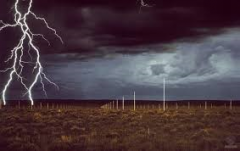
|
Walter de Maria, The Lightning Field, United States, New Mexico 1971–1977. 400 polished stainless steel polesAn area that usually has lightning storms in July and August Grid measures 1 mile by 1 kilometerThe experience you going there and failing to see lighting there is important have to get permission of the DIA foundation |
|
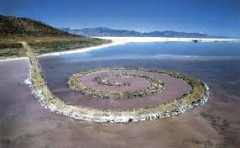
|
Robert Smithson, Spiral Jetty, United States, 1970, Earthwork; black rocks, salt crystals, earth, red water (algae). • Putting his art work in the middle of know were so you would go there and appreciate it unlike other people who don’t acknowledge the artwork is there in other public spaces• With public art, you must make it interesting so that people can notice it. They want to impact people every day. - the water can rise and you can get there and not see anything would change colors Salt Lake of Utah and it changes color depending on how much bacteria, changes colors all the time. Can form ice burgs of salt, rise of water can’t see it. • No one ever goes there. You have to choose to go see it because of the location• Ancient symbol found in many cultures • A jetty: a breakwater constructed to protect or defend a harbor stretch of coast or riverbank only used on ocean don’t need it on the lakes • Won’t be able to know if it will be completely submerged with water or with pink salt • The art is what Nature does to it. • |
|

|
Joseph Mallord William Turner, The Fighting Temeraire Tugged to Her Last Berth to Be Broken Up, England, 1838, oil on canvas. painted it in his old age as a sign of his own life drawing to the end. were lost forever emphasizes the sunset |
|
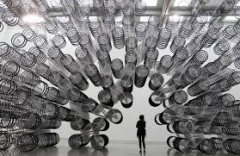
|
Ai Weiwei, Forever Bicycles, China, 2011, 1,200 Forever Bicycles. a very popular transportation but also a defining aspect of the working class overwhelming size points out that humans build their technology big and may be defined by It. |
|
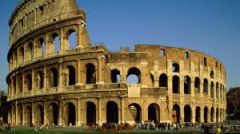
|
Colosseum, Rome, 70–82 CE. Rome- earthquake half came off Every class has own seating areasEmperor has an imperial box Emperor can decide outcomes give mercy They can flood the coliseum Would send out lions and bears for excitement sun was blocked by a huge cloth underground passage areas were added later so that animals could make a dramatic entrance continued until 523 |
|

|
Bull Jumping, Palace Complex at Knossos, Crete, c. 1550–1450 BCE. Man, are-dark color always outside Woman are-white color cuz always inside Acrobat flip over bulls first hold onto horns-it would flip her over onto his back and she would flip off it. Bull sacred animal Occur indoor stadium. bull represent fertility and strength |
|
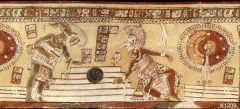
|
Ball Players, Maya, Mexico, 11th–13th centuries, vase painting. Ball court Mayan -gods have played when created the world Illustrate them in awkward poses cant touch ball with hands Cylindrical Vessel with Ballgame The vessel was made to drink chocolate as described in the inscription and chocolate residue has been found in it |
|
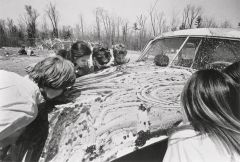
|
Allan Kaprow, Household, May 1964, Performance Happening, New York. Happenings: events conceived by artists and performed not only by the artists themselves but often by the public at the event as well • They are often artily improvised or spontaneous and partly scripted • Allan Kaprow invented them in the late 1950s • Inspired by Jackson Pollock • Flash mobs are often considered a modern form of Happening (but are more scripted) • They usually relate to larger themes or issues, but it can be hard to identify these • For example: community-building, environmentalism, time-based works that can only be experiences (not bought and sold)Fluids: only creating the experience yourself, cuz you can’t go in it. Ice blocks stacked on each other to make a boxHousehold: 1964No spectators, only participantsIt occurred in a trash dump and its meaning is unclear although it Is related to tensions and dynamics between men and woman and the power of violence to separate usA smoking wrecked car was brought to the site and the men covered it in strawberry jam while the women screeched inside the nestThe women licked the jam off the carMen return to car add white bread to the jam and ate jam whileMen take sledgehammers to the wreck and the two groups began to gather peacefully everyone watched the car burn |
|

|
Frank O. Gehry, Guggenheim Bilbao, Bilbao, Spain, 1997. art museum abstract sculpture |
|
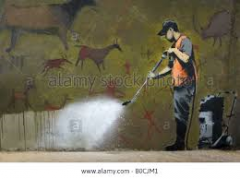
|
Banksy, Graffiti painting depicting worker removing prehistoric cave paintings, 2008. political activist deals with political oppression, sexuality, war and peace the man cleaned up one of his paintings before not knowing it was banksys paid creation so he puts the man in it. |
|
|
1) Abstract Expressionism
|
an art movement that emerged after the World War 11 that emphasized spontaneous artistic seld expression non representational imagery and distinct paint application most abstract expressionist works were paintings
|
|
|
2) amphitheater
|
an oval semi circular or circular arena surrounded by tiers of seats
|
|
|
3) aristocracy
|
the highest class in certain societies
|
|
|
4) barrel vault
|
a system of masonry roofing or ceiling consruction based on the principle of the arch a single arch extended in depth form front to back forming a tunnel like structure |
|
|
5) Bodhisattva
|
in Buddhist believes those human who have attained the level f buddahood but choose to postpone their achieving in Nirvana to remain on Earth to help others
|
|
|
6) Buddha
|
a person who has achieved a state of complete spiritual enlightenment one who is attained nirvana the Buddha is Siddhartha Gautama the spiritual leader form India who founded Buddhism
|
|
|
7) contrapposto
|
A standing position in which the body weight rests on one straight leg with the other leg relaxed and bent giving the torso an s shaped curve
|
|
|
Cubism |
an art style in which multiple viewpoints or facets are represented within one point of view Analytical cubism broke down forms while synthetic cubism used collage and assemblage to represent parts of objects in order to visually play with illusions and reality
|
|
|
earthworks
|
the earth itself as sculptural material
|
|
|
Fauvism |
an early 20th century art movement in Europe lef by henri matisse that focused on bright colors and patterns the term comes from the French word fauve meaning wild beast
|
|
|
futurism
|
an art movement in Italy around 1910 that celebrated the speed energy change and upheaval of the machine age
|
|
|
genre painting
|
paintings that contain subject matter of everyday live
|
|
|
Gothic
|
the history culture and art of western eutope from the 12 thought the 14thc enturies local variations include French gothic and English perpendicular style
|
|
|
graffiti
|
written, drawn or painted on public walls
|
|
|
happenings
|
an art even that is planned by the artist and that may be performed spontaneously and solicit participation of it audience. invented by Allen Kaprow
|
|
|
hinduism
|
the dominant religion of India whose basic believes encompass the cycle of reincarnation and a supreme being in many forms
|
|
|
horizontal registers
|
... In art and archaeology, in sculpture as well as in painting, a register is a vertical level in a work that consists of several levels, especially where the levels are clearly separated by lines; modern comic books typically use similar conventions.
|
|
|
iconoclasm
|
the act of destroying religious images or opposing their veneration
|
|
|
idealized
|
a style of art in which natural imagery is modified in a way that strives for perfection according to the values and aesthetics of particular culture
|
|
|
impressionism
|
a late 19th century painting style originating in Western Europe that attempts to capture subtle light qualities or fleeting moments with small strokes of strong color
|
|
|
industrialization
|
is the process by which an economy is transformed from primarily agricultural to one based on the manufacturing of goods. Individual manual labor is often replaced by mechanized mass production, and craftsmen are replaced by assembly lines.
|
|
|
mandala
|
a design with geometric elements that delineates deities the universe and wholeness in Hinduism or buddhism
|
|
|
mayan
|
. large family of American Indian languages spoken in Central America and Mexico, of which the chief members are Maya and Quiché
|
|
|
mihrab
|
in a mosque a niche in a wall that faces mecca
|
|
|
monotheism
|
a religion distinguished by the belief in only on god
|
|
|
nationalism
|
patriotic feeling, principles, or efforts.
|
|
|
Neoclassical
|
revival of the classical Greek and roman styles in art and architecture as well as styles from the European renaissance
|
|
|
oculus
|
the round opening in the center of a dome
|
|
|
pilgrimage
|
a journey, especially a long one, made to some sacred place as an act of religious devotion
|
|
|
pointillism
|
artist applied daubs of pure pigment to a ground to create an image the paint daubs appear to blend when viewed from a distance
|
|
|
polytheism
|
the belief in many gods with distinct functions
|
|
|
propaganda
|
information, especially of a biased or misleading nature, used to promote or publicize a particular political cause or point of view.
|
|
|
protenstant reformation
|
the 16th-century religious, political, intellectual and cultural upheaval that splintered Catholic Europe, setting in place the structures and beliefs that would define the continent in the modern era.
|
|
|
reliquaries
|
a vessel designed to house a holy relic
|
|
|
rococo
|
architecture music and decorative arts from 18c Europe made primarily for upper class
|
|
|
romanesque
|
an architectural style in medival Europe that contained massive walls barrel caults and rounded arches churches has cross shaped plans
|
|
|
romanticism
|
focused on the intuitive emotional and picturesque it rejected the carefully planned and rationalized compositions of the renaissance and added a dense of mysticism to art
|
|
|
stele
|
a stone slab or tablet that is carved with images or inscriptions usually in commemoration of a person or an event
|
|
|
surrealism
|
influenced by the work of Sigmund Freud fantastic and dream like imagery drawn from the subconscious or automatic drawing similar to doodling
|
|
|
triumphal arc
|
a freestanding roman arch commemorating an important event
|

